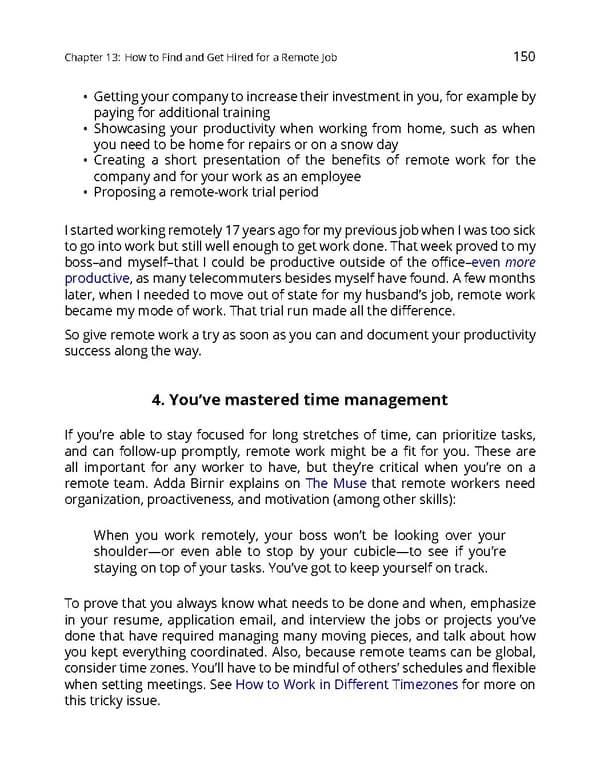Chapter13: HowtoFindandGetHiredforaRemoteJob 150 • Gettingyourcompanytoincreasetheirinvestmentinyou,forexampleby paying for additional training • Showcasing your productivity when working from home, such as when youneedtobehomeforrepairsoronasnowday • Creating a short presentation of the benefits of remote work for the companyandforyourworkasanemployee • Proposing a remote-work trial period I startedworkingremotely17yearsagoformypreviousjobwhenIwastoosick togointoworkbutstillwellenoughtogetworkdone.Thatweekprovedtomy boss–and myself–that I could be productive outside of the office–even more productive,asmanytelecommutersbesidesmyselfhavefound.Afewmonths later, when I needed to move out of state for my husband’s job, remote work becamemymodeofwork.Thattrialrunmadeallthedifference. Sogiveremoteworkatryassoonasyoucananddocumentyourproductivity success along the way. 4. You’ve masteredtimemanagement If you’re able to stay focused for long stretches of time, can prioritize tasks, and can follow-up promptly, remote work might be a fit for you. These are all important for any worker to have, but they’re critical when you’re on a remote team. Adda Birnir explains on The Muse that remote workers need organization, proactiveness, and motivation (among other skills): When you work remotely, your boss won’t be looking over your shoulder—or even able to stop by your cubicle—to see if you’re staying on top of your tasks. You’ve got to keep yourself on track. To prove that you always know what needs to be done and when, emphasize in your resume, application email, and interview the jobs or projects you’ve done that have required managing many moving pieces, and talk about how you kept everything coordinated. Also, because remote teams can be global, considertimezones.You’llhavetobemindfulofothers’schedulesandflexible whensetting meetings. See How to Work in Different Timezones for more on this tricky issue.
 The Ultimate Guide to Remote Work Page 153 Page 155
The Ultimate Guide to Remote Work Page 153 Page 155